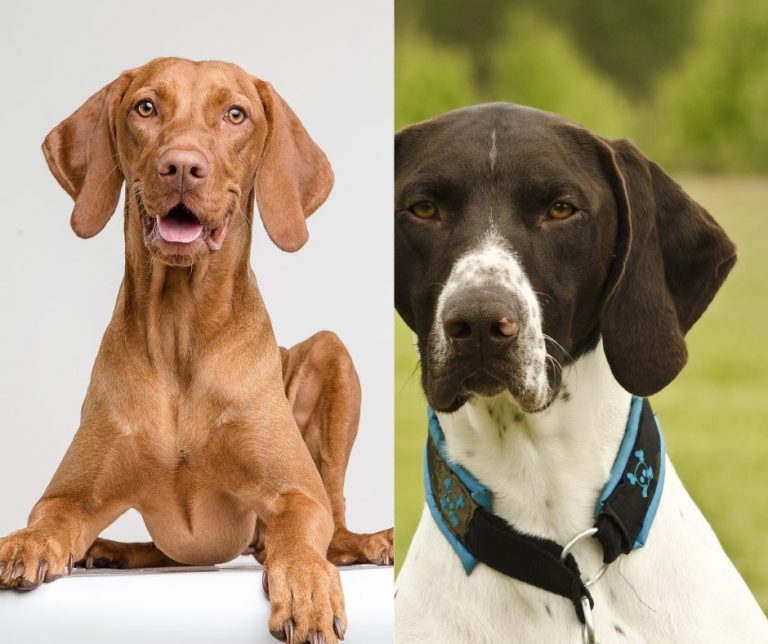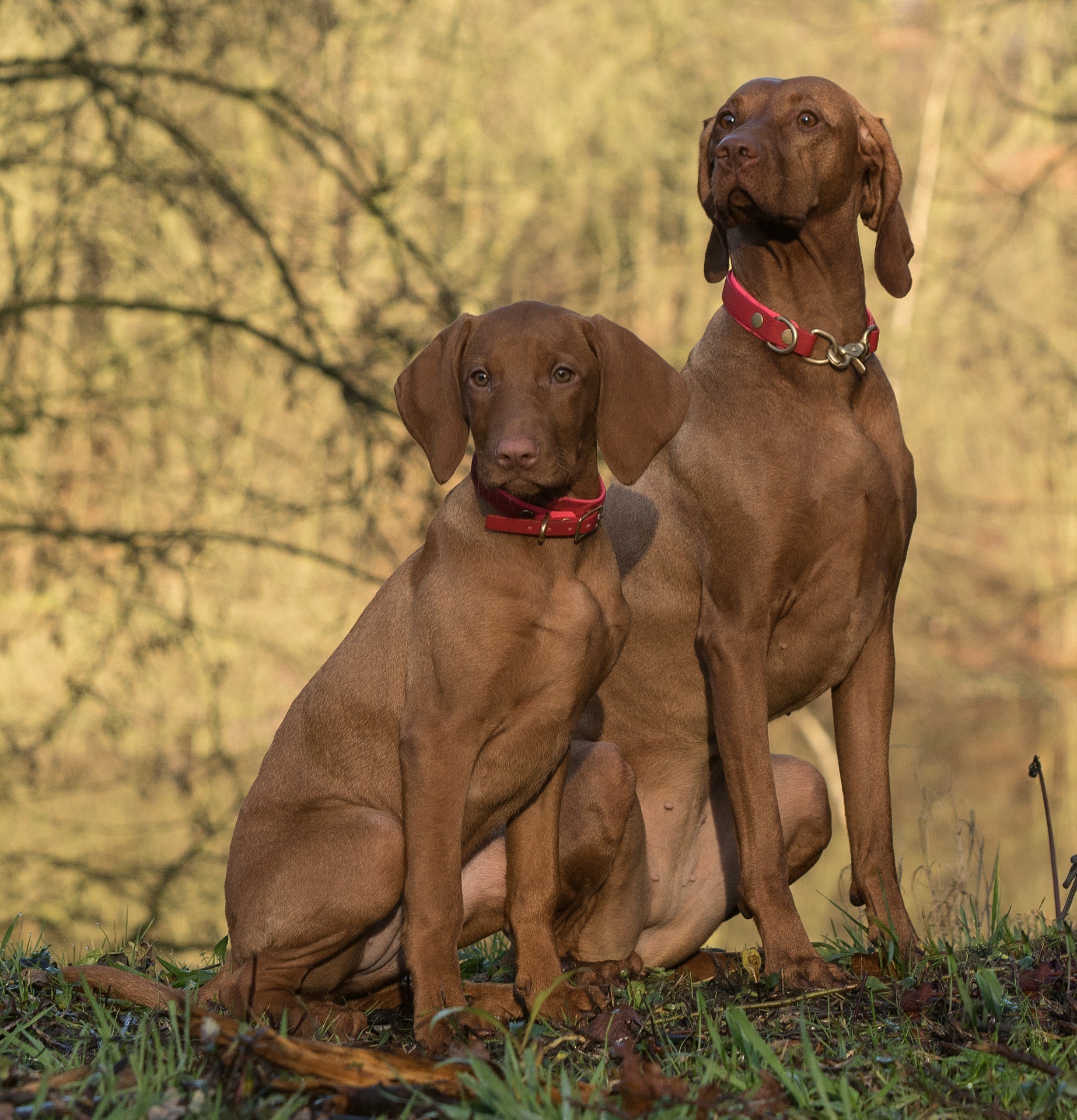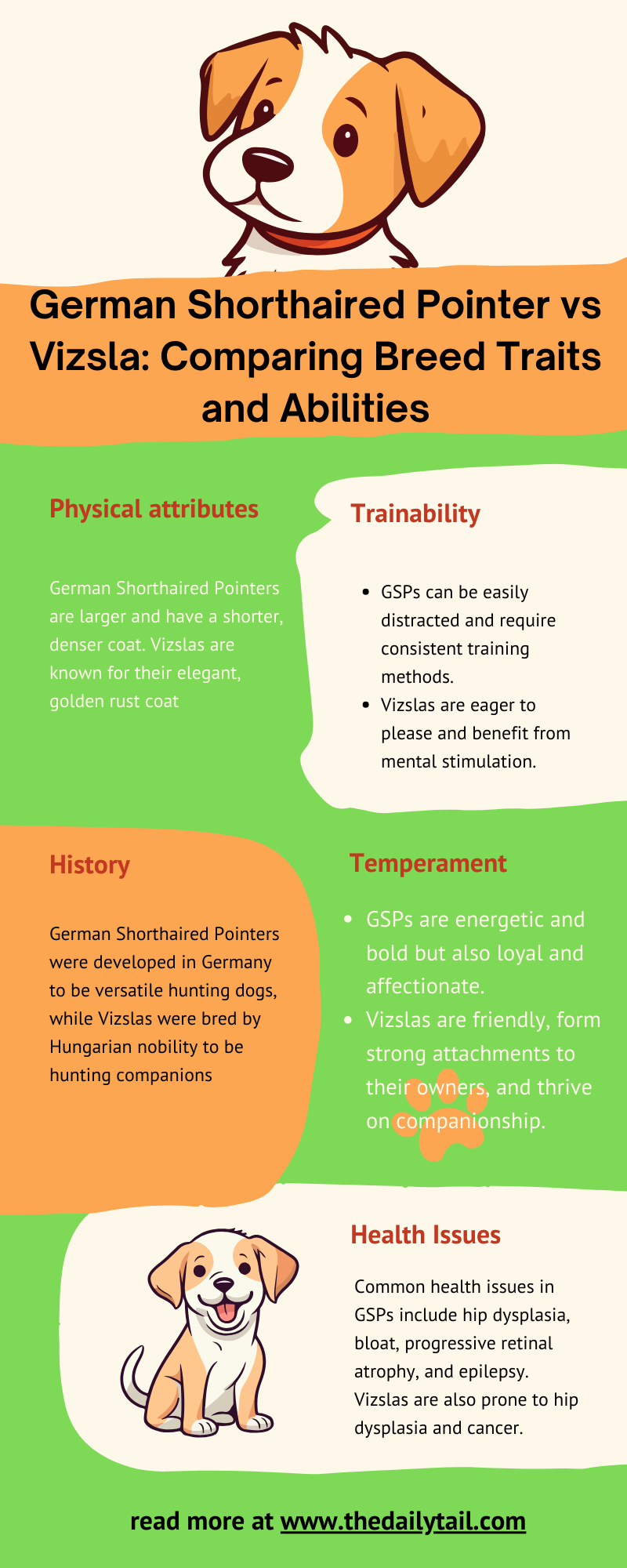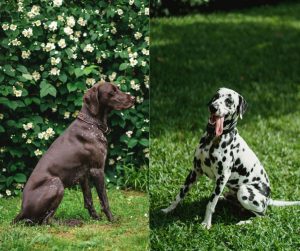The German Shorthaired Pointer and the Vizsla are both esteemed breeds within the hunting dog category, prized for their versatility and athletic prowess. Originating from Germany and Hungary, respectively, both breeds share a common function as skilled gundogs with the ability to point and retrieve. However, despite their similar roles in the field, the German Shorthaired Pointer and the Vizsla have distinct breed histories, physical characteristics, and temperaments that set them apart from each other.
The German Shorthaired Pointer, often referred to as GSP, was developed in the 19th century to be a multipurpose hunting dog. Known for its keen sense of smell and strong tracking abilities, the GSP is a robust and agile companion, with males usually weighing between 55-70 pounds and females 45-60 pounds. Its coat is short and dense, providing protection in various types of terrain and weather conditions.
On the other hand, the Vizsla’s lineage is ancient, with their presence traced back to the early Magyar tribes. The breed is recognized for its high level of intelligence and its strong attachment to its human family. With a sleek golden-rust coat, the Vizsla is slightly smaller than the GSP, with males typically weighing 45-60 pounds and females slightly less. They are admired for their elegant appearance and are sensitive, making them responsive to training with a gentle approach.
Today, our comparison is between the German Shorthaired Pointer vs Vizsla dog breed. Let’s take a look.
Breed Origins and History
The German Shorthaired Pointer and the Vizsla are both revered hunting breeds, each with a distinct history and region of origin. These breeds were developed for their agility, intelligence, and suitability for hunting.
Origins of the German Shorthaired Pointer
The German Shorthaired Pointer (GSP), as its name indicates, has its origins in Germany. The breed’s development began in the 17th century, but it was in the 19th century, specifically in 1872, when the GSP was first recognized by the German Kennel Club. This recognition marked the breed’s formal establishment. Nero and Treff, two pivotal GSPs, competed in the German Derby in 1883, becoming foundational dogs for the breed. They were sought for their versatility in hunting, capable of pointing, retrieving, and trailing both in water and on land.
Vizsla Heritage
The Vizsla’s ancestors were bred by the Magyar warriors in Hungary, who needed dogs that could match the agility and speed of their horses. Selection over the centuries by Hungarian nobility and warlords refined these red-coated dogs, culminating in what is now known as the Vizsla. Brought to the precipice of extinction several times in their history, the Vizslas survived, largely due to the dedicated efforts of breed enthusiasts. Today’s Vizsla is celebrated for its versatility as a swift, efficient hunting dog, recognized for both its pointing and retrieving abilities.
Physical Characteristics
When differentiating between the German Shorthaired Pointer and the Vizsla, their physical characteristics are pivotal. These two breeds possess distinct traits that cater to their originating roles as active hunting dogs.
Size and Build
The German Shorthaired Pointer (GSP) displays a well-built, muscular body indicative of its strength and agility, necessary for versatile hunting. Adult GSPs typically stand between 21-25 inches tall. They weigh in at about 45-70 pounds, with males generally being larger than females. Those are breed standards for the German Shorthaired Pointer dogs set by the American Kennel Club.
In contrast, the Vizsla exhibits a more elegant and slightly leaner build. The Vizsla’s height ranges from 21-24 inches at the shoulder, closely matching the GSP. Their weight is slightly less, ranging from 40-60 pounds. This slimmer profile contributes to the Vizsla’s graceful appearance and reflects their speed and endurance.
Coat and Color
Both the German Shorthaired Pointer and the Vizsla have a short, smooth coat, which is fitting for their active lifestyle, making it easier to maintain.
The coat of a GSP can come in a variety of colors, often presenting in liver, or a combination of liver and white, which may include spots and ticking.
The Vizsla’s coat color is more uniform, typically a solid golden rust. This warm hue is a distinctive feature of the breed and adds to their overall regal appearance.
Distinctive Features
Ears and Tail: The GSP usually has broad, high-set ears that hang down close to the head, adding to their distinctive look, whereas the Vizsla’s ears are also floppy but tend to be thinner and have a rounded ‘V’ shape. Both breeds generally have a docked tail, although the practice varies based on country-specific animal welfare laws.
Body and Fur: The GSP exhibits a shorter, dense fur on a well-proportioned body with a strong back, deep chest, and a tail that’s often docked to a specific length. The Vizsla’s body, while similar in height, often appears more svelte, with a slightly longer neck and overall refined features that accentuate their agility.
In conclusion, the German Shorthaired Pointer and the Vizsla display similar physical dimensions but deviate in build, coat, and coloring, evidencing their distinct breed characteristics.
German Shorthaired Pointer vs Vizsla Temperament
The German Shorthaired Pointer and the Vizsla are both recognized for their distinctive temperaments and personalities, which render them favorable as family and hunting companions. Their energetic and affectionate nature demands an understanding of their behavioral traits and requirements for a harmonious household.
General Disposition
The German Shorthaired Pointer (GSP) is energetic, intelligent, and known for its versatile hunting abilities. These dogs exhibit a keen enthusiasm for work and play, balancing a bold personality with a loyal demeanor. Embodying a dual nature, they are as much at home in the field as they are curled up with their family.
Vizslas possess a similarly friendly and lively spirit. They are often seen as “velcro dogs,” forming strong attachments to their owners and preferring to be involved in family activities. Described as affectionate and loving, the Vizsla’s temperament is well-suited for families and those able to provide ample companionship.
Family and Pet Interaction
German Shorthaired Pointers are highly sociable and tend to be excellent with children, often becoming an integral part of the family unit. They are generally good with other dogs, but their high prey drive necessitates care with smaller pets.
Vizslas are known for being exceptionally family-friendly and child-friendly, thriving on interaction with their human counterparts. Though they can be trained to live harmoniously with other pets, they might not be suitable for homes with small pets due to their hunting instincts.
Adaptability
When considering adaptability, both breeds are better suited to environments that can cater to their active lifestyle. The German Shorthaired Pointer and Vizsla require considerable exercise and do not thrive in small apartments without adequate daily exercise. They are happiest with space to roam, ideally with a large yard, but can adapt to various living situations provided their needs are met with suitable alternatives such as daily walks and mental stimulation.
German Shorthaired Pointer vs Vizsla Exercise and Training Requirements
Both the German Shorthaired Pointer and the Vizsla are high-energy breeds with significant exercise and training needs. They thrive on physical activity and mental challenges, and require consistent training to harness their intelligence and eagerness to please.
Exercise Needs
- German Shorthaired Pointer (GSP):
- Exercise requirement: 1-2 hours per day
- Energy level: High, needs space and varied activities
- Vizsla:
- Exercise requirement: 1+ hour per day
- Energy level: High, enjoys interactive playtimes and long runs
Training and Intelligence
- GSP:
- Training: Highly trainable with focus on positive reinforcement
- Intelligence: Eager to learn and responds well to obedience training
- Vizsla:
- Training: Intelligent and highly responsive to training
- Intelligence: Quick learner, benefits from mental stimulation and clear tasks
Behavioral Traits
- GSP:
- Obedience: Good; they are willing to follow commands with proper guidance
- Focus: Can be distracted, necessary to apply consistent training methods
- Vizsla:
- Obedience: Strong desire to please, making them highly trainable
- Focus: When engaged, they demonstrate a sharp attention to training tasks
Health and Care
When considering the health and care of the German Shorthaired Pointer and the Vizsla, prospective owners should be aware of each breed’s specific needs, including common health issues, grooming requirements, and dietary considerations.
Lifespan and Common Health Issues
Both the German Shorthaired Pointer and the Vizsla generally enjoy a lifespan of around 10-14 years. However, they are susceptible to certain breed-specific health issues. For the German Shorthaired Pointer, hip dysplasia and bloat are common concerns. Progressive retinal atrophy and epilepsy have also been noted in the breed. Vizslas, on the other hand, may face similar issues with hip dysplasia and are also prone to cancer. It is crucial for owners to provide regular veterinary checkups to monitor and mitigate these risks.
Grooming and Maintenance
Grooming needs for both breeds are moderate but essential. The German Shorthaired Pointer has a short, dense coat that requires regular brushing to minimize shedding. The Vizsla’s coat is also short but has a smoother texture, necessitating less frequent grooming. Owners should pay attention to nails, ears, and teeth, as regular maintenance for these areas can prevent common health problems.
- Coat care: Weekly brushing recommended for both breeds
- Nail care: Monthly nail trimming to prevent overgrowth and splitting
- Ear care: Weekly checks for debris and infection
- Dental care: Regular brushing or use of dental chews
Diet and Nutrition
A well-balanced diet is vital for maintaining the health of both German Shorthaired Pointers and Vizslas. These active breeds require high-quality dog food that is appropriate for their life stage (puppy, adult, senior) and activity level. Owners should monitor their dog’s weight to avoid obesity, which can exacerbate issues like hip dysplasia.
- Protein: Essential for muscle development and repair
- Fat: Provides energy but should be given in moderation
- Carbohydrates: Necessary for energy; should come from whole grains and vegetables
Both dogs may require dietary adjustments based on their health needs and veterinary advice.
Breed-Specific Considerations
When comparing the German Shorthaired Pointer and the Vizsla, it is crucial to focus on their hunting skills, adaptability to living environments, and compatibility with other breeds.
Hunting Abilities
The German Shorthaired Pointer (GSP) and Vizsla are both known for their versatile hunting capabilities. GSPs exhibit a strong prey drive, excelling in chasing and scent work with the stamina to hunt all day. They are adept at tracking a variety of game, from waterfowl to small mammals. In contrast, Vizslas are also skilled hunters but generally possess a more moderate prey drive, which can make them slightly less intense in hunting situations.
- German Shorthaired Pointer: High energy, strong chasing instincts, versatile in water and land, excellent at tracking
- Vizsla: Moderately high prey drive, good at pointing and retrieving, known for endurance
Living Environment
Both breeds are active and require ample exercise, but they differ in their adaptability to living spaces. GSPs typically need more space to accommodate their high energy levels and are better suited to homes with larger areas to run and play. Vizslas are more adaptable to various living situations, including apartments, as long as they receive sufficient daily exercise to manage their active nature.
- German Shorthaired Pointer: Large, fenced area needed; not suitable for apartment living
- Vizsla: More adaptable but requires daily vigorous exercise; can live in an apartment if adequately exercised
Breed Compatibility
When it comes to behavior and temperament, both breeds are sociable and kid-friendly if socialized properly. However, their prey drives may affect interactions with other pets like cats, where the GSP’s stronger instinct may lead to chasing. Both the Vizsla and GSP are generally pet-friendly but early socialization is vital to prevent potential aggression towards other dogs.
- German Shorthaired Pointer: Possible chasing behavior; early training to manage strong prey drive
- Vizsla: More likely to coexist peacefully with other pets; less intense prey drive compared to GSP
By considering these breed-specific factors, potential owners can better understand which dog may align with their lifestyle and hunting needs.
Comparison and Choice
When considering a canine companion from the sporting group, the German Shorthaired Pointer (GSP) and the Vizsla are two popular breeds that prospective pet owners often compare. Their distinctive characteristics and similar backgrounds as hunting dogs offer a range of factors to consider for the ideal match.











